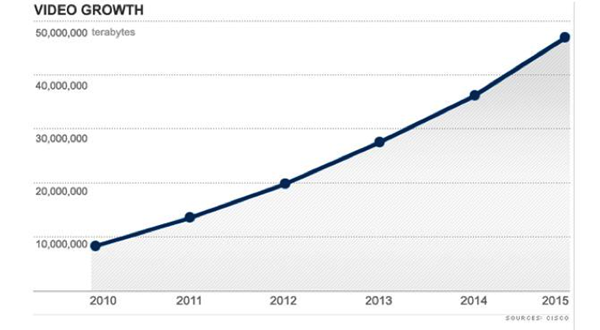Engaged Audience: Reaching Your Audience Across Multiple Screens

TEMPE, AZ.—Organizations are facing increasing pressure to not only get their audience’s attention faster but to keep it. There’s so much digital noise out there that it’s becoming increasingly difficult to do so.
According to a recent study conducted by TechValidate in conjunction with Limelight Networks, organizations are increasingly seeing video as the key method to engaging better with their digital audiences:
1. Eighty-one percent described video as extremely or very important in engaging customers.
2. Eighty-one percent stated that video allowed deeper engagement with audiences.
Of course, this isn’t very surprising. Video is proving to be a crucial tool in any organization’s kit for creating opportunities to engage. Why? Because people like to watch video. And there’s even scientific evidence to back it up. Behavioral psychologist Susan Weinschenk, Ph.D., also known as “the brain lady,” has uncovered four core, very human reasons why we are drawn to video:
1. We focus on the face. Okay, Dr. Weinschenk puts it a little more scientifically than that. According to her, the fusiform face area (part of the brain that assists in analyzing visual perceptions) makes us pay attention to human faces. Not only that, but the FFA is connected to the emotional areas of the brain, so when you can see someone’s face, you’re not only paying attention, you’re also processing emotional information, so you are processing information in a deeper way.
2. Voice makes more meaning. When we hear a human voice speaking, we are more apt to convert the information into meaningful content.
3. Seeing is believing! When we see people have emotional experiences (versus reading about them and trying to imagine them), we have a greater connection. Body language is a powerful feature of human-to-human interaction.
4. It’s all about movement. Since the Stone Age, we’ve survived by noticing the moving things around us. Fail to notice? Get eaten. This attention to movement in our peripheral vision is deeply ingrained in our anthropological DNA. We are drawn to things that move, like video.
According to Google’s 2012 Multi-Screen World study, our time online is spread between four primary media devices. And don’t think that organizations are flocking to video just because it’s trendy. People are watching it. In droves. Check out how much video has grown over the past few years, and is expected to grow in the coming years.
Of course, Cisco keeps adjusting its projections. In the latest Visual Networking Index, they up the ante: “Two-thirds of the world’s mobile data traffic will be video by 2017. Mobile video will increase 16-fold between 2012 and 2017, accounting for over 66 percent of total mobile data traffic by the end of the forecast period.”
But it’s not all rainbows and unicorns. Organizations face an increasingly difficult task in ensuring people can watch their video. The culprit? Mobile. According to the Tech Validate/Limelight study:
1. The top concern of respondents (77 percent) was distributing content across multiple types of devices.
2. Sixty-nine percent of respondents cited the ability to effectively format content for mobile devices as a top operational challenge.
Mobile is where everyone is. In fact, according to Google’s 2012 Multi-Screen World study, people are using all of their devices each day to access content, including video.
And what’s more, many people are starting a video on their smartphone or tablet and then finishing it on their computer. Google’s 2012 Multi-Screen World study says smartphones are the most common starting place for online activities.
Okay, so what can you do? How can you tackle the challenges posed by mobile so you can reap the rewards of better attention and engagement? Here are a few things to keep in mind:
1. Produce a single master file. Use a standard codec like H.264 to produce a master file that can be converted easily into mobile formats like HLS for Apple devices and desktop formats like Flash or Silverlight.
2. Capture requesting device. Know which device is requesting your video by analyzing the incoming request. With a little bit of JavaScript connecting device to file format type, you can deliver the correct format for each device.
3. Analyze viewer behavior. You may be producing lots of extra video formats that no one is requesting! You can stop that by understanding who is viewing what, and from what device.
4. Conversion in the cloud. There are a number of providers in the market (such as YouTube and even Limelight Networks) that can provide you “anytime, anywhere” delivery for your mobile video. That means video is transformed into different formats when it’s requested. So no extra storage is needed for different formats (as long as you are following that first bit of advice).
5. Make it short. Your mobile audience isn’t watching full-length movies on their devices, for the most part. Keep the video you send to mobile short enough that your viewers will watch it. If you need to deliver longer pieces, do it in two parts: the first part is 15 seconds or so, to grab their attention, and the second part is longer. That way you can pack the message you really want to convey into the shorter piece to make sure it gets communicated.
There are no hard-and-fast rules for overcoming the challenges of delivering video to mobile. You just have to be aware that mobile has challenges (different formats for different devices, for example) that can get in the way of video’s promise of better engagement.
Jason Thibeault is senior director, marketing, at Limelight Networks.
Get the TV Tech Newsletter
The professional video industry's #1 source for news, trends and product and tech information. Sign up below.
